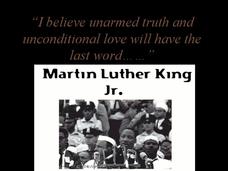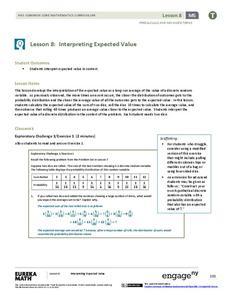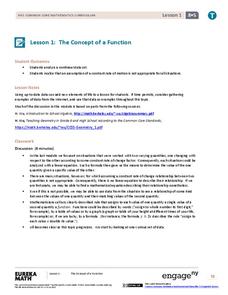Curated OER
The Verbs Have, Do, and Go
Using this simple activity could be a good way for your youngsters to practice using the verbs have, do, and go. By filling in the answers to the 12 questions, learners identify the correct verb.
Curated OER
What Does George W. Bush Have in Common With Past U.S. Presidents?
Sixth graders discover what it takes to become President of the United States. Using a database, they complete a scavenger hunt to determine what George W. Bush has in common with past Presidents. They also create a spreadsheet which...
Curated OER
Martin Luther King Jr.
This PowerPoint displays a selection of important events from the life of Martin Luther King Jr., and has relevant and clear photos to accompany short facts. There are a number of slides listing quotes and values with regard to...
K12 Reader
The Man Has a Can
Add this -an word resource into your plan for the day! Kids can read the poem, which includes several -an words to practice with, and then answer the three included reading comprehension questions.
Amani Project
The 5 Elements of Music
A series of activities teach young musicians that they don't need a room full of instruments to make music. The second activity in the Amani Project has participants use their hands, feet, and voices to demonstrate the five elements of...
PreKinders
Community Helper Word Cards
What does a dentist do? What about a farmer? Explore different jobs with a set of picture word cards. Each card in a set of 12 features the name of a career with a picture of the person who has that job.
NASA
MASS, MASS – Who Has the MASS? Analyzing Tiny Samples
What is it worth to you? A hands-on lesson asks groups to collect weights of different combinations of coins and calculate weighted averages. They use the analysis to understand the concept of an isotope to finish the third lesson in a...
Pearson
Conclusions: Must, Have (Got) To, May, Might, Could, Can't
Is this presentation the perfect addition to a grammar unit? It must be! Learn about drawing conclusions with different levels of certainty, using must, might, could, and can't.
Illustrative Mathematics
Who Has the Best Job?
Making money is important to teenagers. It is up to your apprentices to determine how much two wage earners make with their after school jobs. Participants work with a table, an equation, and a graph and compare the two workers to see...
Simon & Schuster
Classroom Activities for The Red Badge of Courage by Stephen Crane
Three activities comprise an eight-page packet designed to accompany a study of Stephen Crane's The Red Badge of Courage. First, class members investigate the types of recruiting posters used today, analyze the types of appeals used,...
K12 Reader
Have You Got the Time?
Time and time measurement is the subject of a comprehension learning exercise that asks kids to read a short passage about time, and then respond to a series of questions based on the article.
PBS
Inspector Detector
How do spacecraft detect magnetic fields? The fourth installment of a five-part unit has learners develop a device with magnets that allows for the detection of magnetic fields. They use a map of an imaginary planet to try out their...
Balanced Assessment
Dot Patterns
Use geometric patterns to teach your class how to write functions. The assessment task has scholars consider a pattern of dots to draw the next picture of the pattern. Pupils then analyze the pattern, which helps them develop a function...
American Chemical Society
Chemistry and Comics
Copying the comics couldn't be easier. A fun and simple activity has young scientists rub the back of a comic strip with a spoon to see if the ink will transfer to a white sheet of paper. They then repeat the experiment, rubbing...
University of Utah
Geometry Part 2: Measurement in 2- and 3-Dimensions, Plane Sections of Solids
What kind of tree does a math teacher climb? A geometry! Here is a lesson that includes all the geometry resources you could ever wish for in one comprehensive workbook. Class members demonstrate what they have learned by...
Teach Engineering
Density and Miscibility
The liquids did not mix — so what do density columns have to do with it? The seventh part in a series of nine provides the theoretical explanation of why density columns do not mix. The lesson covers the topics related to...
EngageNY
Interpreting Expected Value
Investigate expected value as a long-run average. The eighth installment of a 21-part module has scholars rolling pairs of dice to determine the average sum. They find aggregate data by working in groups and interpret expected value as...
TryEngineering
Graphics: Bits and Points
What can a mural teach pupils about computer science? The lesson has scholars create a mural on a wall to learn about bitmap and vector graphics. Along the way, they learn about the graphics coordinate system.
EngageNY
The Concept of a Function
Explore functions with non-constant rates of change. The first installment of a 12-part module teaches young mathematicians about the concept of a function. They investigate instances where functions do not have a constant rate of change.
Tech Museum of Innovation
Lighter than Air
Scholars participate in two design challenges concerning flight in the second instructional activity of the series. They design balloon crafts that have neutral buoyancy and forward motion.
PhysEdGames
Red-Light Green-Light
Choose a person to be the stoplight. Have everyone else line up on the opposite side of the gym. If "green light" is called out, the players run toward the stoplight person until they hear "red light," which means stop. Anyone that does...
Teach Engineering
Egg Drop
Don't drop the ball on the resource ... drop an egg instead! A teacher-led demonstration has the class consider how to drop eggs into glasses when a tray is in the way. Hint: If you've ever seen a magician pull a tablecloth off a table,...
Concord Consortium
Integer Solutions
Experiment with integer relationships. Young scholars consider integers that have a sum of 10. They begin with two integers, then three, four, and more. As they consider each situation, they discover patterns in the possible solutions.
National Endowment for the Humanities
How to Win a World War
High schoolers are have begun to learn the art of diplomacy with each other, but do they understand how diplomacy works at a global level? The second in a series of four lessons, guides scholars in evaluating primary sources....
Other popular searches
- 1st Grade Grammar Has/have
- Helping Verbs Have Has
- I Have Who Has
- Have and Has
- I Have Who Has Game
- Using Has and Have
- Have To/has To
- Verbs Has and Have
- Have Got Has Got
- Have Has Had
- Language Has and Have
- Have Got /Has Got























